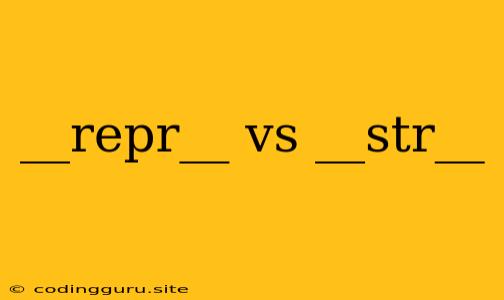In the realm of Python programming, the concepts of __repr__ and __str__ often intertwine, leading to confusion for newcomers and even seasoned developers. While both methods are used to represent objects as strings, they serve distinct purposes. Understanding the nuances between these two methods is crucial for building robust and readable Python code. Let's embark on a journey to decipher the differences between __repr__ and __str__.
What is __repr__?
The __repr__ method, short for "representation", is responsible for providing an unambiguous string representation of an object. This representation is intended for developers and primarily focuses on conveying the object's structure and content. The goal is to create a string that, when evaluated, could recreate the original object.
Here's how it works:
- When you call
repr(object), Python calls the__repr__method of that object. - The method should return a string that is a valid Python expression.
- This expression, if evaluated, should recreate the original object.
Example:
class Car:
def __init__(self, brand, model, year):
self.brand = brand
self.model = model
self.year = year
def __repr__(self):
return f"Car(brand='{self.brand}', model='{self.model}', year={self.year})"
my_car = Car("Toyota", "Camry", 2023)
print(repr(my_car))
Output:
Car(brand='Toyota', model='Camry', year=2023)
This output is a valid Python expression that can be used to reconstruct the my_car object.
What is __str__?
The __str__ method, short for "string", aims to provide a human-readable representation of an object. Its primary purpose is to present the object's information in a way that is easy for users to understand.
Here's how it works:
- When you call
str(object), Python calls the__str__method of that object. - The method should return a string that is intended for human consumption.
- The string doesn't necessarily need to be a valid Python expression.
Example:
class Car:
def __init__(self, brand, model, year):
self.brand = brand
self.model = model
self.year = year
def __repr__(self):
return f"Car(brand='{self.brand}', model='{self.model}', year={self.year})"
def __str__(self):
return f"This is a {self.year} {self.brand} {self.model}."
my_car = Car("Toyota", "Camry", 2023)
print(str(my_car))
Output:
This is a 2023 Toyota Camry.
The output is a more human-readable description of the my_car object.
Key Differences Between __repr__ and __str__
- Purpose:
__repr__focuses on unambiguous representation for developers, while__str__provides a human-readable description for users. - Output:
__repr__returns a string that is a valid Python expression, while__str__returns a string that is intended for human consumption. - Default Behavior: If an object does not define
__str__, Python will fall back to using the__repr__method. - Use Cases:
__repr__is helpful for debugging and logging, while__str__is suitable for displaying information to users.
When to Use __repr__ and __str__
Here's a general guideline for choosing between __repr__ and __str__:
__repr__: Use for unambiguous representation, particularly for debugging and logging.__str__: Use for human-readable output, especially when displaying information to users.
Tips for Implementing __repr__ and __str__
- Consistency: Aim for consistency between
__repr__and__str__. - Readability: Make the outputs clear and easy to understand.
- Minimalism: Keep the strings as concise as possible.
- Information Content: Include relevant information in the strings.
Conclusion
In Python, __repr__ and __str__ provide distinct ways to represent objects as strings. Understanding their differences and using them appropriately can significantly enhance your code's readability and debugging capabilities. By adhering to the best practices outlined above, you can write clear and informative code that effectively communicates the state of your objects.
